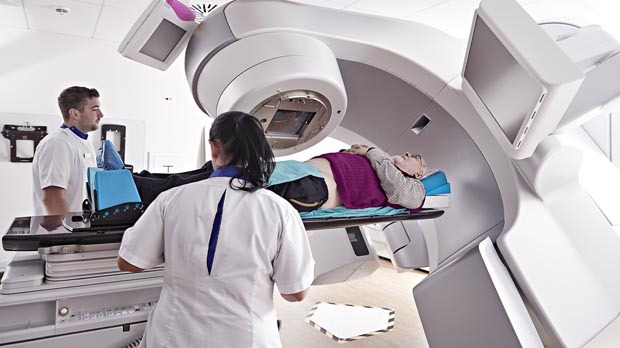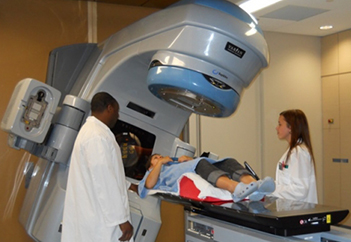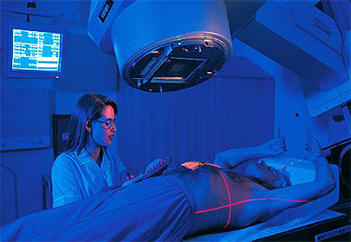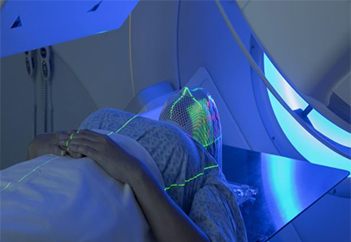Radiotherapy
Radiation therapy (also called radiotherapy) is a cancer treatment that uses high doses of radiation to kill cancer cells and shrink tumors. At low doses, radiation is used in x-rays to see inside your body, as with x-rays of your teeth or broken bones.
What to know about radiation therapy?
• A doctor may recommend radiation for cancer at different stages. In the early stages, radiation therapy can help reduce the size of a tumor before surgery or kill the remaining cancer cells afterward. In the later stages, it may help relieve pain as part of palliative care.
• One form of radiation treatment involves using a machine that produces a beam of radiation. The beam targets a specific area of the body. Another type involves putting a radioactive substance inside the body, either permanently or temporarily.
• Radiation therapy uses waves of energy, such as light or heat, to treat cancers and other tumors and conditions. The form of radiation used in cancer therapy is a high-energy type known as ionizing radiation.
• Scientists still do not know exactly how radiation works as a treatment for cancer. They do know, however, that it breaks up the DNA of cancer cells in a way that disrupts their growth and division. In this way, radiation can kill cancer cells, preventing or slowing the spread of the disease.
• Sometimes a doctor prescribes radiation therapy alone, but usually, they recommend it in combination with other treatments, such as chemotherapy, surgery, or both.
There are many types of cancer. Learn more here: https://www.medicalnewstoday.com/articles/323648.php
Trusted Source ... Side effects
Radiation can affect healthy cells as well as cancerous ones. When this happens, a person experiences side effects.
the area receiving treatment
the person's overall health
the type and doses of radiation
Short term side effects
Short term side effects radiation therapy include fatigue, skin changes, and nausea.
Short term side effects vary, depending on the part of the body receiving radiation.
A 2018 study published in BMJ Open recommends screening for anxiety and depression in people undergoing radiation therapy and offering counseling services to those who may benefit from them.
the area receiving treatment
the person's overall health
the type and doses of radiation
Short term side effects
Short term side effects radiation therapy include fatigue, skin changes, and nausea.
Short term side effects vary, depending on the part of the body receiving radiation.
A 2018 study published in BMJ Open recommends screening for anxiety and depression in people undergoing radiation therapy and offering counseling services to those who may benefit from them.

This is the most common type. It involves an external machine emitting a beam of radiation that targets the treatment area.
Different forms are available, depending on the need. High-energy beams, for example, can target cancer that is deeper within the body.
Different forms are available, depending on the need. High-energy beams, for example, can target cancer that is deeper within the body.
There are different types of internal radiation therapy. Both involve implanting or introducing a radioactive substance into the body.
Brachytherapy involves inserting a radioactive implant in or close to the cancerous tissue. The implant may be temporary or permanent. Another type of internal radiation therapy involves drinking or receiving an injection of radioactive liquid.
Brachytherapy involves inserting a radioactive implant in or close to the cancerous tissue. The implant may be temporary or permanent. Another type of internal radiation therapy involves drinking or receiving an injection of radioactive liquid.
is to limit the extent to which healthy tissue around the cancer is exposed to the radiation. Doctors may recommend this treatment for prostate or ovarian cancer, for example.
A doctor may recommend undergoing both main types of radiation therapy. The decision will depend trusted Source on:
the type of cancer
the size of the tumor
the tumor's location, including the types of tissue nearby
the person's age and overall health
other treatments
Scientists continue to explore ways of improving radiation techniques to achieve more effective outcomes with the least possible risk.
A doctor may recommend undergoing both main types of radiation therapy. The decision will depend trusted Source on:
the type of cancer
the size of the tumor
the tumor's location, including the types of tissue nearby
the person's age and overall health
other treatments
Scientists continue to explore ways of improving radiation techniques to achieve more effective outcomes with the least possible risk.
The doctor will discuss radiation therapy and other options and help weigh the pros and cons. Before treatment starts, they will determine the right type and dosage of radiation.
A person receiving external beam radiation may undergo a CT or MRI scan before treatment. This is to pinpoint the exact location and size of the tumor. A doctor may make a permanent but small mark on the skin to ensure that the radiation therapist will target the beam correctly.
A person may need to wear a plaster cast or use a headrest or another device to ensure that they stay still during treatment. The first session may be a simulation, in which the team runs through the procedure.
Many people have five sessions per week for 3–9 weeks, but this depends on specific factors. Each session lasts for around 15 minutes. Radiation therapy is painless, but there will be damage to the surrounding tissue. This is why the treatment occurs on only 5 days per week. The 2-day break allows for some healing.
A person who has internal radiation therapy may require an anesthetic before the doctor can implant the radioactive substance. Overall, several sessions and some time in the hospital may be necessary.
The details of the process depend on the type of radiation therapy and the type and location of cancer.
A person receiving external beam radiation may undergo a CT or MRI scan before treatment. This is to pinpoint the exact location and size of the tumor. A doctor may make a permanent but small mark on the skin to ensure that the radiation therapist will target the beam correctly.
A person may need to wear a plaster cast or use a headrest or another device to ensure that they stay still during treatment. The first session may be a simulation, in which the team runs through the procedure.
Many people have five sessions per week for 3–9 weeks, but this depends on specific factors. Each session lasts for around 15 minutes. Radiation therapy is painless, but there will be damage to the surrounding tissue. This is why the treatment occurs on only 5 days per week. The 2-day break allows for some healing.
A person who has internal radiation therapy may require an anesthetic before the doctor can implant the radioactive substance. Overall, several sessions and some time in the hospital may be necessary.
The details of the process depend on the type of radiation therapy and the type and location of cancer.
Aftercare...
After receiving external treatment, a person can go home and continue with their daily routine.
• Helps
However, they may experience:
- Tiredness.
- Sensitivity around the treatment site.
- Emotional distress.
To help manage these effects, it is important to:
- Get plenty of rest.
- Eat healthfully.
- Talk to friends and family about any side effects.
- Follow instructions, which may involve skincare, from the treatment team.
- Avoid spending time in the sun, due to a risk of photosensitivity.
- Also, monitor for adverse effects and tell the doctor if they occur. The doctor may recommend additional treatments aimed at relieving these.
- People may need to speak to their employers about adjusting work schedules or taking medical leave.
- Tiredness.
- Sensitivity around the treatment site.
- Emotional distress.
To help manage these effects, it is important to:
- Get plenty of rest.
- Eat healthfully.
- Talk to friends and family about any side effects.
- Follow instructions, which may involve skincare, from the treatment team.
- Avoid spending time in the sun, due to a risk of photosensitivity.
- Also, monitor for adverse effects and tell the doctor if they occur. The doctor may recommend additional treatments aimed at relieving these.
- People may need to speak to their employers about adjusting work schedules or taking medical leave.




